Canine Respiratory System
Just as in humans, the basic function of the canine respiratory system is to bring oxygen into the body and remove carbon dioxide from it. This very important task may be interrupted by several diseases, and knowing the symptoms of these diseases can help you help your dog to live a long, healthy life.
Structure of the Canine Respiratory Tract
Your dog’s respiratory tract is divided into two sections: the upper tract, comprised of the nasal cavities, the nasopharynx, the larynx, and the trachea; and the lower tract, made up of the bronchi and lungs.
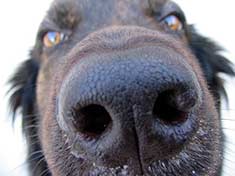
Air enters the nose through the nostrils, also known as the anterior nares. Mucus secreted by the nasal glands acts as a filter to strain out dust, germs, and other particles which may be present in room air. The air swirls around the spongy turbinate bones in the nasal cavities, where it is moistened and warmed to body temperature, then enters the nasopharynx through the posterior nares.
The pharynx, composed of the nasopharynx and the oropharynx, is that area at the back of the throat where the mouth opens to the esophagus allowing food to travel to the stomach, and the nose opens to the trachea carrying air to the lungs.
To prevent food from going into the lungs and air from going into the stomach, a small piece of cartilage known as the epiglottis acts as a gatekeeper, directing air and food to their proper destinations. The motion of the tongue during the swallowing process forces the epiglottis to close over the trachea. When the tongue is not moving, the epiglottis is positioned to direct air into the lungs via the larynx and trachea.
The trachea is simply an air-transportation tube made up of rings of cartilage. It is lined with small hairs called cilia which further filter any impurities from the air. When the cilia are irritated by a foreign object, they trigger the dog to begin coughing to bring up the object. The vocal chords are located at the top of the trachea. These elastic structures determine the pitch of the dog’s bark.
The Lower Respiratory Tract
Just below the base of the heart, the end of the trachea splits in two, then into seven bronchi, feeding the seven lobes of the lungs. The bronchi continue branching into smaller and smaller diameter tubes until they become bronchioles. These bronchioles further narrow and end in small sacs known as alveoli. The alveoli have very thin membranes, allowing blood gasses to be exchanged. As blood passes through the lung tissue, oxygen is absorbed into the red blood cells for distribution throughout the body, and carbon dioxide is dropped off into the alveoli making the reverse trip to be expelled from the body when the dog exhales.
Canine Respiration
Under the control of the medulla oblongata in the brain, your dog’s respiratory cycle continues automatically, at a normal rate of about 15 – 30 cycles per minute. The rate of respiration can be increased by exercise, increased temperature, fear, or anger. Decreases in respiratory rate come with relaxation and sleep.
When the dog’s brain senses a build-up of carbon dioxide in the body, it signals the chest muscles to expand the chest, and the lungs expand to fill up the empty space, pulling in oxygen-rich air from the environment. The air travels through the lungs and the blood gasses are exchanged, displacing carbon dioxide with oxygen. As the chest muscles relax, the chest cavity becomes smaller, pushing out the carbon dioxide-filled air.
What’s all that panting about?
In addition to exchanging carbon dioxide for oxygen in the blood, a dog’s respiratory system is responsible for controlling the dog’s body temperature. Because dogs have very few sweat glands (located in their foot pads), they need to breathe hard to cool their bodies. The movement of air, as well as the evaporation of the saliva in the mouth, cools the dog on hot days.
Respiratory illnesses in dogs
Diseases of the respiratory system can be caused by infection, inhalation of a foreign substance, or by an over-reaction of the immune system. You will be able to notice a respiratory problem because your dog will begin coughing or wheezing. Untreated, a respiratory disease will cause your dog’s breathing to become labored.
Kennel cough, more properly called tracheobronchitis, is caused by an infection of the dog’s respiratory tract. The most common culprit is Bordetella brochiseptica, but other organisms that cause kennel cough include viruses like distemper, parainfluenza, adenovirus, and some mycoplasmal organisms. The symptom you will see first is a dry, hacking cough that sounds as if your dog has a bone stuck in his or her throat. Your dog may also retch at the end of each coughing fit.
As the name implies, kennel cough is passed quickly to other dogs in close proximity to the ill dog. If you have more than one dog, it is likely all will become infected if one does. Treatment includes controlling the cough and killing the infection with antibiotics, if it is bacterial. Antibiotics have no effect on viral causes of kennel cough, but because about 90% of kennel cough is caused by the Bordetella bacteria, most veterinarians will routinely treat with antibiotics.
Pneumonia may result from a variety of events, but the most common cause is a viral infection of the lower respiratory tract. Less commonly, the dog may aspirate food into the lungs if the epiglottis does not properly protect the airway during swallowing. Fungi, bacteria, and parasites may also cause pneumonia.

The body’s reaction is to produce inflammation and mucus to try to control the problem. Regardless of the cause of the pneumonia, your dog will almost certainly develop a bacterial infection as the mucus sits in the lungs and festers. The dog’s breathing will become labored and he or she may run a fever and be excessively tired. In addition, you may notice a deep cough that produces mucus.
Although a number of diseases can produce a cough, when you see the other symptoms noted above, your vet may decide to do a chest X-ray to confirm or rule out the diagnosis of pneumonia. Depending on how far the disease has progressed, your dog may be stable, unstable, or critical. A stable dog can be treated at home, while an unstable dog may need IV therapy at a clinic to thin the mucus and allow the dog to cough it up. A critical dog must be given oxygen therapy and may need 24-hour a day monitoring, as his or her ability to exchange blood gasses through the lungs has become impaired.
Once your dog is stabilized, you will be able to continue his or her treatment at home. Home treatment consists of keeping the dog away from very cold or wet weather, using a vaporizer, giving the dog light exercise and coupage treatments to promote coughing, and giving antibiotics as directed. Coupage is a treatment that involves patting the dog’s chest and upper back to loosen and break up mucus to allow the dog to cough it up.
The more pus and mucus your dog can get rid of by coughing, the better. A dog with pneumonia should never be treated with cough suppressants because you want him or her to get the infection out of the lungs, which can best be achieved by deeply coughing.
Tracheal Collapse occurs when the cartilage of the trachea breaks down, causing the opening of the airway to become compromised. It is most common in small or toy dogs, especially if they are overweight.
As the dog begins to have trouble breathing through the compromised airway, he or she may begin to become anxious, causing more rapid breathing, which makes the problem worse. The collapsed airway will become inflamed and begin to produce mucus. As the dog coughs, the inflamed tissue produces more and more mucus, making the respiratory distress worse.
Other than the cough, you will likely not know your dog has a collapsed trachea until another problem complicates the condition. For example, if your vet has to operate on your dog for some other reason, he or she may notice a collapsed trachea when an endotracheal tube cannot be passed down the dog’s throat. Irritants such as dust or cigarette smoke in the air can cause symptoms to worsen, as can the development of a secondary respiratory infection like kennel cough.
To treat a collapsed trachea, your vet will likely advise you to put your dog on a weight loss program and consider purchasing air filters to reduce the irritants in the air in your home. You will also need to stop smoking around your dog. Cough suppressants or possibly steroids can be used to reduce the amount of mucus produced by the inflamed trachea, and antibiotics may be given to clear any secondary bacterial infections. If these treatments are not successful, surgery may be required to insert a prosthetic airway.
Reverse Sneezing is caused by a spasm of the soft palate and throat, making a noise that sounds as if the dog is inhaling sneezes. The spasm causes the trachea to narrow, and the dog will extend his or her neck and expand the chest in an effort to move more air into the lungs. Brachycephalic dogs such as Pugs and Boxers are prone to this condition, particularly if they are small. Irritants in the air, excitement, pulling on a leash, allergies, and even perfume can kick off a reverse sneezing attack. Although no specific treatment is usually needed, you may be able to stop the spasm by massaging the dog’s throat or covering the dog’s nostrils which will force him to swallow and clear out the irritation.
Bracycephalic respiratory syndrome affects those dogs with pushed in faces like Pugs and Boxers. Because it is tough to fit all of the necessary respiratory structures into the short head of these dogs, many of the structures become compressed. The soft palate may flap down into the throat, creating a snorting sound when the dog breathes. Actual respiratory distress is rare, but the dog will make the snorting sound, particularly when he or she is sleeping.
The biggest risk with brachycephalic dogs is their susceptibility to heat stroke. Because of the obstructions associated with their short heads, these dogs cannot pant efficiently enough to cool their bodies. Care must be taken to keep brachycephalic dogs in cool environments with access to plenty of water. Controlling the dog’s weight is also vital to prevent further obstruction.
Help! My dog won’t stop snoring!
Dogs may snore for a variety of reasons such as allergies, irritants like cigarette smoke, or obesity. Pekinese, Pugs, and Boston Terriers are prone to snoring because their tracheae flatten as they breathe. Anything that narrows the airway can cause snoring.
If your dog suffers from allergies, you must reduce the amount of allergens in his or her environment to relieve the snoring. Vacuum often and clean the dog’s bedding frequently to remove possible sources of allergens. Keep the dog indoors when pollen levels are high in your area, and avoid areas where there are lots of pollution-producing vehicles. Don’t smoke around your dog, as smoke is a respiratory irritant.
If your dog is overweight, simply putting him or her on a diet and exercise program may relieve the problem.
If you can get your dog to sleep using a pillow, snoring may be reduced as his or her sleep posture changes.
As a last resort, surgical options may be available, although snoring in and of itself is not harmful. If your dog has never snored before and suddenly begins snoring, it may be indicative of a problem such as a tumor which should be checked out by a veterinarian.
Doggies Den: Latest Articles
 Homemade Thanksgiving Treats for Your Dog
Homemade Thanksgiving Treats for Your Dog
NUTRITION We all want to include our dogs in our holiday celebrations, but hopefully, you're aware that sharing table scraps with your dog isn't always the best idea.
 Keeping Your Dog Safe during the Summer Months
Keeping Your Dog Safe during the Summer Months
HEALTH Summer is coming on fast, so it’s time to plan how you will keep your dog safe and healthy through the lazy, carefree, warm days.
 Vaccination Time Again-Keeping Your Puppy Healthy
Vaccination Time Again-Keeping Your Puppy Healthy
DOG HEALTH So you have your new puppy picked out. There are quite a few shots, treatments and examinations that will keep the newest member of your family healthy.
 Canine Thanksgiving Feast
Canine Thanksgiving Feast
NUTRITION With the wide variety of food at Thanksgiving dinner, chances are you'll want to give your dog something special, too. If you're contemplating what to feed your dog for the holiday, here is a guide to a great Canine Thanksgiving Feast.
 Dog Walking Tips Every Owner Should Know
Dog Walking Tips Every Owner Should Know
DOG FUN Walking your dog is not only crucial to keeping him healthy and happy, it strengthens the bond between your canine friend and his caregiver. There are a lot of obstacles out there. Don’t forget these simple tips to keep your walk fun and safe in the outside world.
 The Benefits of Physiotherapy for your Dog
The Benefits of Physiotherapy for your Dog
HEALTH The same techniques that physiotherapists use to treat a variety of injuries and conditions in humans have been adapted to suit animals with great success. Family pets, show dogs, and working dogs can all benefit greatly from physiotherapy. Dogs whose activities involve a lot of agility are especially susceptible to the types of problems that physiotherapy can address.
 The Decision- Adding a Dog to Your Family
The Decision- Adding a Dog to Your Family
FIRST TIME OWNERSBringing a dog into your family is a decision where many people don’t realize it’s magnitude until after they have the dog. There are a number of things that you need to research before you decide to purchase a dog, and it starts right in your own home.
 Bringing Your Dog Into Your New Baby's Life
Bringing Your Dog Into Your New Baby's Life
HEALTH Many believe that a dog and a new baby cannot happily coexist, so therefore the dog has to go. This is not necessarily the case.  A new baby does not mean you have to abandon your dog.

Doggies Den:
Most Popular Articles

Dog Pregnancy Symptoms
HEALTHIf you suspect your dog might be pregnant, check out part one in this series on pregnant dogs, where we cover pregnant dog symptoms.
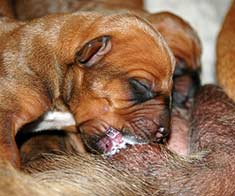
Dog Birth
HEALTHIn the third article of our dog pregnancy series, we look at the wonderful, but messy, process of bringing newborn puppies into the world.

Indoor Dog Potties
DOG PRODUCTSIt's been a long day at work. You were so busy, you didn't even take time to eat a sandwich, let alone run home to let your dog out. You're on your way home, knowing the poor dog is crossing his or her legs by now, when your car breaks down, delaying you even further. Can't somebody make this easier?
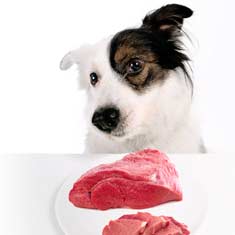
Your Dog’s Digestive System
PHYSIOLOGYEver wonder why your dog eats so fast? Or why he eats gross things? Or why he gets sick to his stomach? Or why his waste stinks so bad? Some of these things are normal, some are not.

Canine Respiratory System
BREATHINGThe basic function of your dog's respiratory system is to bring oxygen in to and remove carbon dioxide from the body. Knowing the symptoms of respiratory diseases can help you help your stay healthy.
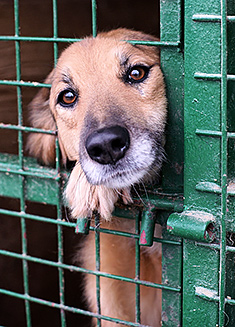
Shelter Dog Adoption Tips for Success
ADOPTION Are you intimidated by the prospect of "rescuing" a dog from a shelter? One reason that you may be wary of adopting a dog from a shelter is not knowing how to choose. Adopting a dog from a shelter can be a rewarding process, if you're prepared to do a reasonable amount of research.

Canine Urinary Tract Infections
SYMPTOMS AND TREATMENTDoes your dog seem to be having trouble relieving his or her bladder? Learn how to recognize the signs of urinary tract infections and how to treat them before they spread.

What to do for Dog Diarrhea
SYMPTOMS AND REMEDIESIf you have dogs in your house for any length of time, you have likely experienced at least one bout of dog diarrhea. Beyond the pain in the tuckus involved in cleaning up the mess, you should know what causes diarrhea, and when it's important to see the vet.
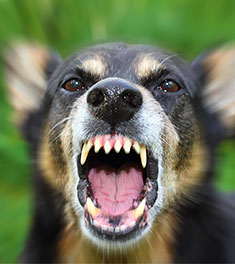
What to do for a Dog Bite
DOG BEHAVIOR Getting bitten by a dog can be scary, and you may be tempted to run around in circles for a while, trying to figure out what to do. Here's our guide to help you manage the situation.

Top Ten Tips for Living with a Senior Dog
DOG HEALTH Bringing home a new puppy is so exciting, but it doesn’t take all that long for your exuberant puppy to grow into a senior dog who may have special needs. Here are the doggies.com top ten tips for taking care of your companion who has been with you through so much.
